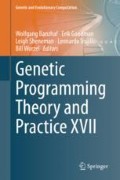Abstract
The paper evaluates GP’s competitiveness in business data science-driven applications and suggests the necessary steps to increase its reach, impact and competitiveness. First, the key business needs for Data Science are identified and discussed, followed by an analysis of the competitive landscape and popularity of Data Science methods. The competitive advantages and weaknesses of GP as well its impressive application record are reviewed. Two business applications with high value creation—inferential sensors and nonlinear business forecasting—are identified and described. The recommended action items to increase competitive presence of GP in Data Science business applications include: develop a successful marketing strategy toward statistical, machine/deep learning, and business communities; broaden application areas; improve professional development tools; and increase GP visibility and teaching in Data Science classes.
Access this chapter
Tax calculation will be finalised at checkout
Purchases are for personal use only
References
Amir, G., Amir, A., Rayon, C. (eds.): Handbook of Genetic Programming Applications. Springer (2015)
Centurion, C.: The power of optimizing supply and demand simultaneously. https://blog.riverlogic.com/optimizing-supply-and-demand-simultaneously (2014)
Duzhin, F., Gustafson, A.: Machine learning-based app for self-evaluation of teacher-specific instructional style and tools. Educ. Sci 8, 2–15 (2018)
Dwarshuis, N.J., Song, H.W., Patel, A., Kotanchek, T., Roy, K.: Functionalized microcarriers improve t cell manufacturing by facilitating migratory memory t cell production and increasing cd4/cd8 ratio. bioRxiv p. 646760 (2019)
Gunning, D.: Explainable Artificial Intelligence (XAI). https://www.darpa.mil/attachments/XAIProgramUpdate.pdf (2017)
Gusel, L., Brezornik, M.: Application of genetic programming for modelling of material characteristics. Expert Systems with Applications 38, 15,014–15,019 (2011)
Gustafson, S., Narasimhan, R., Palla, R., Yousuf, A.: Using genetic programming for data science: lessons learned. In: R. Riolo, W. Worzel, M. Kotanchek, A. Kordon (eds.) Genetic Programming Theory and Practice XIII, Genetic and Evolutionary Computation, pp. 117–135. Springer (2016)
Kordon, A.: Marketing computational intelligence in industry. In: Proceedings of CEC 2010, Barcelona, pp. 3185–3192 (2010)
Kordon, A.: Applying data mining in raw materials forecasting. In: SAS Analytics 2012 Conference, Las Vegas (2012)
Kordon, A.: Applying genetic programming in business forecasting. In: R. Riolo, T. McConaghy, E. Vladislavleva (eds.) Genetic Programming Theory and Practice XI, Springer Series on Genetic and Evolutionary Computation, pp. 101–117. Springer (2014)
Kordon, A.: Applying data science: How to create value with artificial intelligence. Springer (2020)
Kordon, A., Castillo, F., Smits, G., Kotanchek, M.: Application issues of genetic programming in industry. In: T. Yu, R. Riolo, B. Worzel (eds.) Genetic Programming Theory and Practice III, Springer Series on Genetic and Evolutionary Computation, pp. 241–258. Springer (2005)
Kordon, A., Jordaan, E., Castillo, F., Kalos, A., Smits, G., Kotanchek, M.: Competitive advantages of evolutionary computation for industrial applications. In: Proceedings of CEC 2005, Edinburgh, UK, pp. 166–173 (2005)
Kotanchek, M., Smits, G., Kordon, A.: Industrial strength genetic programming. In: R. Riolo, B. Worzel (eds.) Genetic Programming Theory and Practice I, pp. 239–256. Kluwer (2003)
Kovacic, M., Sarler, M.: Application of the genetic programming for increasing the soft annealing productivity in steel industry. Materials and Manufacturing Processes 24, 369–374 (2009)
Okhovat, A., Mousavi, M.: Modeling of arsenic, chromium and cadmium removal by nanofiltration process using genetic programming. Applied Soft Computing 12, 793–799 (2012)
Pearl, J., Mackenzie, D.: The book of Why: The new science of cause and effect. Basic Books, NY (2018)
Poli, R., Langdon, W., McPhee, N.: A field guide to genetic programming. Lulu Selfpublishing (2008)
Rey, T., Kordon, A., Wells, C.: Applied data mining for forecasting using SAS. SAS Press (2012)
Rostami, A., Arabloo, M., Ebadi, H.: Genetic programming approach for prediction of supercritical co2 thermal conductivity. Chemical Engineering Research & Design 122, 164–175 (2017)
Smits, G., Kordon, A., Jordaan, E., Vladislavleva, C., Kotanchek, M.: Variable selection in industrial data sets using pareto genetic programming. In: T. Yu, R. Riolo, B. Worzel (eds.) Genetic Programming Theory and Practice III,, pp. 79–92. Springer (2006)
Smits, G., Kotanchek, M.: Pareto front exploitation in symbolic regression. In: U. O’Reilly, T. Yu, R. Riolo, B. Worzel (eds.) Genetic Programming Theory and Practice II, pp. 283–300. Springer (2004)
Sonebi, M., Cevic, A.: Genetic programming based formulation for fresh and hardened properties of self-compacting concrete containing pulverized fuel ash. Construction and Building Materials 23, 2614–2622 (2009)
Taylor, J.: Best practices for picking the right kpis for your business. https://www.klipfolio.com/blog/best-practices-for-picking-business-kpis (2016)
Venegas, P.: Asymmetric trust and causal reasoning in blockchain-based ais. In: Proceedings of IXth International Conference on Complex Systems, Cambridge, USA, pp. 44–55 (2018)
Author information
Authors and Affiliations
Corresponding author
Editor information
Editors and Affiliations
Rights and permissions
Copyright information
© 2020 Springer Nature Switzerland AG
About this chapter
Cite this chapter
Kordon, A., Kotanchek, T., Kotanchek, M. (2020). How Competitive Is Genetic Programming in Business Data Science Applications?. In: Banzhaf, W., Goodman, E., Sheneman, L., Trujillo, L., Worzel, B. (eds) Genetic Programming Theory and Practice XVII. Genetic and Evolutionary Computation. Springer, Cham. https://doi.org/10.1007/978-3-030-39958-0_8
Download citation
DOI: https://doi.org/10.1007/978-3-030-39958-0_8
Published:
Publisher Name: Springer, Cham
Print ISBN: 978-3-030-39957-3
Online ISBN: 978-3-030-39958-0
eBook Packages: Computer ScienceComputer Science (R0)

